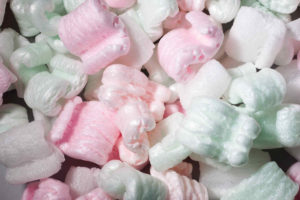 Apart from bubble wrap, packing peanuts (also called foam peanuts or packaging peanuts) are another widely used packing materials. They are used as fillers and cushioning material used to prevent damage to fragile objects during shipping. They are light-weight and shaped to interlock when compressed, providing a soft padding to the items they protect. At least two inches of packing peanuts on all sides, top and bottom of a package are recommended for optimum cushioning and protection.
Apart from bubble wrap, packing peanuts (also called foam peanuts or packaging peanuts) are another widely used packing materials. They are used as fillers and cushioning material used to prevent damage to fragile objects during shipping. They are light-weight and shaped to interlock when compressed, providing a soft padding to the items they protect. At least two inches of packing peanuts on all sides, top and bottom of a package are recommended for optimum cushioning and protection.
The first packing peanuts were introduced by Dow Chemical Company in 1965. They were made from 100% virgin polystyrene resin and take on the shape and size of a peanut in its shell, hence the name. They were invented as an alternative to heavier traditonal packing materials and help cut shipping costs for businesses and individuals.
Today, packing peanuts come in a variety of shapes such as “S”, “figure 8” and “W”, as well as colors which are indicative of what they are made from. For instance, white packing peanuts are usually made from 70% or more virgin resin while pink means the peanuts have been treated with a chemical to prevent static cling. pink peanuts are best used when shipping electronics.
As a response to environmental concerns associated with polystyrene-based packing peanuts, green packing peanuts were introduced. They are usually made from 70% or more recycled polystyrene. In the early 1990s, an environmentally friendly variety of packing peanuts was introduced. These type of peanuts are usually made from natural raw materials such as sorghum and corn starch and will disintegrate naturally over time. They are also non-toxic and will not harm humans and pets when ingested accidentaly.
Aside from being very light-weight (usually around 3 grams per litre/0.17 to 0.2 lb per cu ft), another advantage of packing peanuts over other filling materials are their ability to fill nooks and crannies inside a package with ease unlike form-fitting packing supplies like foam blocks and foam padding. They can also be reused over and over again to cushion items of varying shapes and sizes.
Because of their negative impact on the environmental, non-biodegradable packing peanuts must be disposed off properly. If possible, save peanuts received from incoming shipments and re-use them for future packing and mailing needs. Alternatively, they can be sent to moving or shipping stores, donated to schools and churches which can use them in children’s crafts, or taken to a recycling facility for proper handling.
